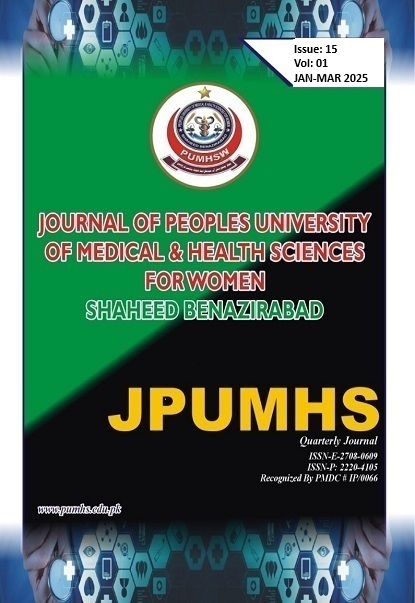PERIOPERATIVE ANALGESIC PRACTICES AND POSTOPERATIVE PAIN MANAGEMENT IN OPHTHALMIC SURGERIES: A CROSS-SECTIONAL STUDY FROM A TERTIARY CARE HOSPITAL IN PAKISTAN.
JPUMHS; 2025:15:01, 137 145. http://doi.org/10.46536/jpumhs/2025/15.01.607
Keywords:
Ophthalmologic Surgical Procedures; Analgesia; Postoperative Pain; Pain Management; Perioperative CareAbstract
BACKGROUND: Effective perioperative and postoperative pain management is essential for
ensuring optimal recovery and patient satisfaction in ophthalmic surgery. However, analgesic
practices often vary depending on the type of surgery and institutional protocols.
OBJEVCTIVE: This study aimed to evaluate perioperative therapy, analgesic use, and their
associations with different ophthalmic surgical procedures in a tertiary care hospital setting.
METHODS: A descriptive cross-sectional study was conducted among 231 patients
undergoing various ophthalmic surgeries. Data were collected regarding demographic
characteristics, ASA physical status, perioperative medications, and postoperative analgesic
use. Frequencies, percentages, means, and standard deviations were calculated. Associations
between type of surgery and analgesic administration were examined. RESULTS:
The study population had a mean age of 67 ± 14 years, with 54.1% males. ASA II status was
most prevalent (64.5%). Preoperative sedatives were administered to only 45.9% of patients.
Atropine (80.1%) and neostigmine (80.5%) were the most common intraoperative agents.
Postoperative analgesia was not administered in 45.9% of patients. Diclofenac (26.8%) and
metamizole sodium (29.9%) were the most frequently used analgesics. Analgesic use was
highest among patients undergoing enucleation (83.3%) and evisceration (80.0%), while
cataract surgeries had the lowest (10.0%). A single dose on the first postoperative day was the
most common pattern (52.8%). CONCLUSION:
Analgesic use following ophthalmic surgery is inconsistently applied, with nearly half of
patients receiving no pain relief. Invasive procedures showed higher analgesic needs,
highlighting the need for standardized, procedure-specific pain management protocols to
ensure adequate postoperative care.
Downloads
Downloads
Published
How to Cite
Issue
Section
License

This work is licensed under a Creative Commons Attribution-NoDerivatives 4.0 International License.




